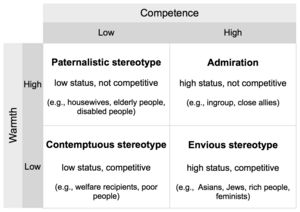The out-group homogeneity effect is the perception of out-group members as more similar to one another than are in-group members, e.g. "they are alike; we are diverse". Perceivers tend to have impressions about the diversity or variability of group members around those central tendencies or typical attributes of those group members. Thus, outgroup stereotypicality judgments are overestimated, supporting the view that out-group stereotypes are overgeneralizations. The term "outgroup homogeneity effect", "outgroup homogeneity bias" or "relative outgroup homogeneity" have been explicitly contrasted with "outgroup homogeneity" in general, the latter referring to perceived outgroup variability unrelated to perceptions of the ingroup.
Susan Tufts Fiske is an American psychologist who serves as the Eugene Higgins Professor of Psychology and Public Affairs in the Department of Psychology at Princeton University. She is a social psychologist known for her work on social cognition, stereotypes, and prejudice. Fiske leads the Intergroup Relations, Social Cognition, and Social Neuroscience Lab at Princeton University. Her theoretical contributions include the development of the stereotype content model, ambivalent sexism theory, power as control theory, and the continuum model of impression formation.
Infrahumanisation is the tacitly held belief that one's ingroup is more human than an outgroup, which is less human. The term was coined by Jacques-Philippe Leyens and colleagues in the early 2000s to distinguish what they argue to be an everyday phenomenon from dehumanization associated with extreme intergroup violence such as genocide. According to Leyens and colleagues, infrahumanisation arises when people view their ingroup and outgroup as essentially different and accordingly reserve the "human essence" for the ingroup and deny it to the outgroup. Whether a "subhuman" classification means "human but inferior" or "not human at all" may be academic, as in practice it corresponds to prejudice regardless.
Laurie A. Rudman is a social psychology feminist professor as well as the Director of the Rutgers University Social Cognition Laboratory who has contributed a great deal of research to studies on implicit and explicit attitudes and stereotypes, stereotype maintenance processes, and the media's effects on attitudes, stereotypes, and behavior on the Feminism movement. She was awarded the 1994 Gordon Allport Intergroup Relations Prize for her research examining the effects of sexist advertising on men's behavior toward female job applicants.

Admiration is a social emotion felt by observing people of competence, talent, or skill exceeding standards. Admiration facilitates social learning in groups. Admiration motivates self-improvement through learning from role-models.
Self-categorization theory is a theory in social psychology that describes the circumstances under which a person will perceive collections of people as a group, as well as the consequences of perceiving people in group terms. Although the theory is often introduced as an explanation of psychological group formation, it is more accurately thought of as general analysis of the functioning of categorization processes in social perception and interaction that speaks to issues of individual identity as much as group phenomena. It was developed by John Turner and colleagues, and along with social identity theory it is a constituent part of the social identity approach. It was in part developed to address questions that arose in response to social identity theory about the mechanistic underpinnings of social identification.

In social psychology, a stereotype is a generalized belief about a particular category of people. It is an expectation that people might have about every person of a particular group. The type of expectation can vary; it can be, for example, an expectation about the group's personality, preferences, appearance or ability. Stereotypes are often overgeneralized, inaccurate, and resistant to new information. A stereotype does not necessarily need to be a negative assumption. They may be positive, neutral, or negative.
Ambivalent sexism is a theoretical framework which posits that sexism has two sub-components: "hostile sexism" (HS) and "benevolent sexism" (BS). Hostile sexism reflects overtly negative evaluations and stereotypes about a gender. Benevolent sexism represents evaluations of gender that may appear subjectively positive, but are actually damaging to people and gender equality more broadly. For the most part, psychologists have studied hostile forms of sexism. However, theorists using the theoretical framework of ambivalent sexism have found extensive empirical evidence for both varieties. The theory has largely been developed by social psychologists Peter Glick and Susan Fiske.
Ambivalent prejudice is a social psychological theory that states that, when people become aware that they have conflicting beliefs about an outgroup, they experience an unpleasant mental feeling generally referred to as cognitive dissonance. These feelings are brought about because the individual on one hand believes in humanitarian virtues such as helping those in need, but on the other hand also believes in individualistic virtues such as working hard to improve one's life.
Benevolent prejudice is a superficially positive prejudice that is expressed in terms of positive beliefs and emotional responses, which are associated with hostile prejudices or result in keeping affected groups in inferior positions in society. Benevolent prejudice can be expressed towards those of different race, religion, ideology, country, sex, sexual orientation, or gender identity.
Hostile prejudice is the outward expression of hate for people of a different race, religion, ideology, country, sex, sexual orientation, or gender identity. Anyone who goes against specific criteria of dress, cultural or moral beliefs, or religious or political ideologies are subject to hostile racism. This racism often leads to direct discrimination to anyone who does not fit the prejudiced person's idea of a "normal" person. This behavior is most prevalent when there are noticeable differences between ingroups and outgroups, with the outgroup members experiencing hostile prejudice from ingroup members.
Moral development focuses on the emergence, change, and understanding of morality from infancy through adulthood. The theory states that morality develops across a lifespan in a variety of ways and is influenced by an individual's experiences and behavior when faced with moral issues through different periods of physical and cognitive development. Morality concerns an individual's reforming sense of what is right and wrong; it is for this reason that young children have different moral judgment and character than that of a grown adult. Morality in itself is often a synonym for "rightness" or "goodness." It also refers to a specific code of conduct that is derived from one's culture, religion, or personal philosophy that guides one's actions, behaviors, and thoughts.

Amy Joy Casselberry Cuddy is an American social psychologist, author and speaker. She is a proponent of "power posing", a self-improvement technique whose scientific validity has been questioned. She has served as a faculty member at Rutgers University, Kellogg School of Management and Harvard Business School. Cuddy's most cited academic work involves using the stereotype content model that she helped develop to better understand the way people think about stereotyped people and groups. Though Cuddy left her tenure-track position at Harvard Business School in the spring of 2017, she continues to contribute to its executive education programs.
A conflict is a struggle and a clash of interest, opinion, or even principles. Conflict will always be found in society; as the basis of conflict may vary to be personal, racial, class, caste, political and international. Conflict may also be emotional, intellectual, and theoretical, in which case academic recognition may, or may not be, a significant motive. Intellectual conflict is a subclass of cultural conflict, a conflict that tends to grow over time due to different cultural values and beliefs.
The maternal wall is a term referring to stereotypes and various forms of discrimination encountered by working mothers and mothers seeking employment. Women hit the maternal wall when they encounter workplace discrimination because of past, present, or future pregnancies or because they have taken one or more maternity leaves. Women may also be discriminated against when they opt for part-time or flexible work schedules. Maternal wall discrimination is not limited to childcare responsibilities. Both men and women with caregiving responsibilities, such as taking care of a sick parents or spouse, may also result in maternal wall discrimination. As such, maternal wall discrimination is also described as family responsibilities discrimination. Research suggests that the maternal wall is cemented by employer stereotypes and gender expectations.
In social psychology, a positive stereotype refers to a subjectively favourable belief held about a social group. Common examples of positive stereotypes are Asians with better math ability, African Americans with greater athletic ability, and women with being warmer and more communal. As opposed to negative stereotypes, positive stereotypes represent a "positive" evaluation of a group that typically signals an advantage over another group. As such, positive stereotypes may be considered a form of compliment or praise. However, positive stereotypes can have a positive or negative effect on targets of positive stereotypes. The positive or negative influence of positive stereotypes on targets depends on three factors: (1) how the positive stereotype is stated, (2) who is stating the positive stereotype, (3) in what culture the positive stereotype is presented.
Intergroup relations refers to interactions between individuals in different social groups, and to interactions taking place between the groups themselves collectively. It has long been a subject of research in social psychology, political psychology, and organizational behavior.
In social psychology, a metastereotype is a stereotype that members of one group have about the way in which they are stereotypically viewed by members of another group. In other words, it is a stereotype about a stereotype. They have been shown to have adverse effects on individuals that hold them, including on their levels of anxiety in interracial conversations. Meta-stereotypes held by African Americans regarding the stereotypes White Americans have about them have been found to be largely both negative and accurate. People portray meta-stereotypes of their ingroup more positively when talking to a member of an outgroup than to a fellow member of their ingroup.
In social psychology, social projection is the psychological process through which an individual expects behaviors or attitudes of others to be similar to their own. Social projection occurs between individuals as well as across ingroup and outgroup contexts in a variety of domains. Research has shown that aspects of social categorization affect the extent to which social projection occurs. Cognitive and motivational approaches have been used to understand the psychological underpinnings of social projection as a phenomenon. Cognitive approaches emphasize social projection as a heuristic, while motivational approaches contextualize social projection as a means to feel connected to others. In contemporary research on social projection, researchers work to further distinguish between the effects of social projection and self-stereotyping on the individual’s perception of others.
Peter Samuel Glick is an American social psychologist and the Henry Merritt Wriston Professor in the Social Sciences at Lawrence University. He is known for his research on gender stereotyping and ambivalent sexism. In 2022, Glick, Amy Cuddy, and Susan Fiske were honored with the Society of Experimental Social Psychology's Scientific Impact Award for their 2002 paper proposing the stereotype content model.



